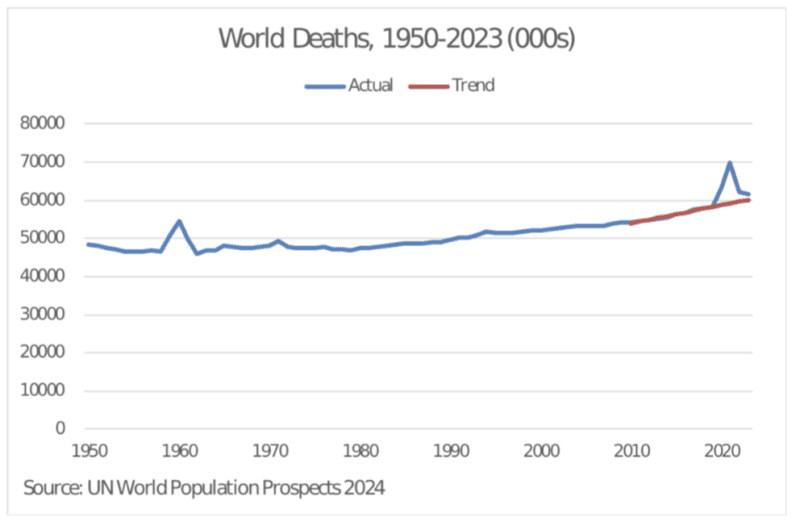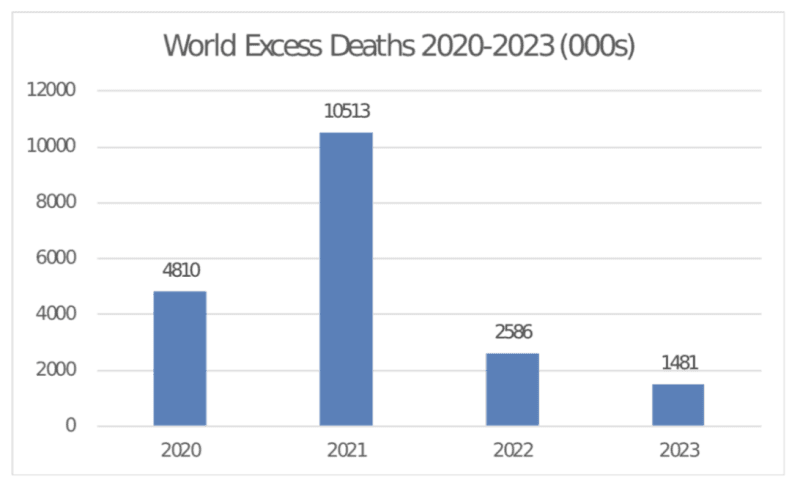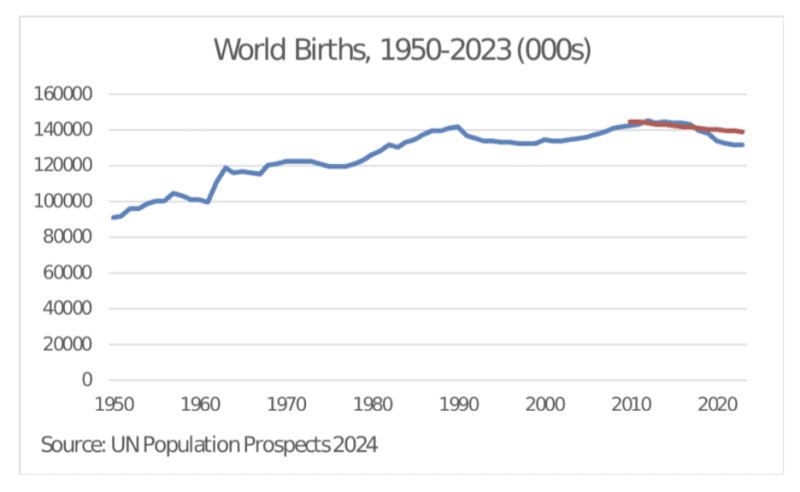Into the Abyss: How Bad Can the Covid Vaccine Story Get?
by Gigi Foster at Brownstone Institute
All Brownstone readers know that the Covid vaccines should never have been mandatory and should never have been prescribed to children or pregnant women, groups for which they were not tested. All of us have been alarmed to see stories of surprisingly many sudden heart failures, turbo cancers, and failed pregnancies in the days and months following the rollout of these shots.
How bad can it be? What is the worst estimate of the impact of the Covid vaccines on the count of living humans for which there is both some degree of empirical evidence and biological plausibility? Let us look into the heart of darkness and consider the worst.
Domain 1: Worldwide Excess Deaths
The principal source for global mortality data is the United Nations World Population Prospects, which at the time of writing had not been updated with a definitive number for 2024. We therefore only use data through 2023. Below we plot the total number of deaths in the world since 1950, and add to that a projection of the 10-year trend before 2020 through to 2023 (shown in the graph below as a red line). The numbers reveal that yearly death counts change fairly smoothly over time, except when humans do something stupid like the Great Leap Forward of 1958-1962, which corresponds to the previous big spike in world deaths evident on the graph and which has been estimated to have cost the lives of around 45 million people.

The (always positive) differences between actual deaths and expected deaths for each of the four years from 2020 to 2023 are depicted in the following graph.

The rounded total of excess deaths – relative to what would have been expected based on the prior 10-year trend – for these four years is 19.4 million people.
Of course, the excess in 2020 cannot be due to the Covid vaccines, so the 4.8 million excess deaths in 2020 would have to be attributed to a combination of the virus itself plus the lockdowns and related policy responses. The cumulative excess after 2020 of 14.6 million deaths could potentially, in the worst-case scenario (from the perspective of the vaccine manufacturers and pushers), be ascribed entirely to the vaccines.
However, we can plausibly assume that if it was the virus and lockdowns that collectively killed 4.8 million extra people in 2020, then at least 75% of them were frail and elderly people who would have died anyway, Covid or no Covid, in the years immediately following (in the US, 75% of deaths from Covid occurred in people aged 65 and over, and 93% were aged 50 and over).
If these deaths were simply brought forward by the virus and the lockdowns, then about 3.6 million people were not around to die who otherwise would have in the ensuing few years. In other words, we would expect a total of 3.6 million fewer deaths relative to the ten-year trend as our baseline counterfactual death count for the few years following 2020.
Applying this adjusted counterfactual by adding in these 3.6 million ‘missing negative excess deaths’ yields an excess death total that could plausibly be due to the vaccines of 18.2 million. To our eyes, this is the maximum possible number of excess deaths that can be defended on the basis of these data as due to the vaccines, given that there was no clear reason other than the one explained above to expect the 10-year death-count trend projected from 2019 to overestimate deaths in the following years.
This estimate of 18.2 million lines up reasonably well with the hotly contested number of 17 million Covid vaccine deaths claimed by Denis Rancourt and coauthors in a 2023 study. There have been claims of up to 31 million deaths, but they are not likely if one believes the world death numbers published by the UN.
Could things be even worse than these statistics suggest, due to data fiddling? Authorities may well have intentionally hidden deaths from view in some regions, but this is difficult to imagine in rich countries with well-functioning death reporting protocols, and where lots of systems (like inheritances) feed off of death registries and force those registries to be somewhat honest. Manipulation is easier to imagine in places like India, where there is no good registry of who lives in the country anyway, and where authorities would have been keen to avoid recognition or embarrassment about any explosion of deaths on account of their own policies.
India’s policies included the ruthless lockdowns that took away the livelihoods of hundreds of millions of poor people and the zealous distribution of vaccines beginning in January 2021, including the locally produced Covaxin that was authorised for use just six weeks after its Phase III clinical trial began. (Achieving Phase III trial results, after the initial creation of a new vaccine candidate, would ordinarily take years.)
It is possible that data integrity concerns could mean that the excess deaths through 2023 due to Covid vaccines are in fact well above 20 million, and equally possible that other factors such as longer-run health damage from lockdowns or bad hospital treatment protocols are responsible for some of the excess deaths since mid-2021.
Our goal is to estimate a defensible maximum death toll due to the vaccines, and for this, 18.2 million is our best guess. That number tallies up well with other estimates for the US (championed by Peter McCullough) that the Covid vaccines have cost 400,000 to 700,000 deaths: the world has about 25 times more people in it than the US does, and 25 times 700,000 is 17.5 million.
Domain 2: Lost Babies
How many babies could possibly have been lost as a direct consequence of the Covid vaccines, due to reduced biological fertility, actual loss of unborn life via miscarriages, or a failure of men and women to meet or to engage in sexual activity for vaccine-related reasons (due, for example, to feeling ill with post-vaccination symptoms)?
Again, world data on births is the place to look, with the pre-2020 trend line projected for the Covid era and plotted in red in the graph below. Unlike world deaths, world births change more erratically over time which makes accurate projections after 2019 more difficult, but as with total deaths, we project based on the trend in the 10 years before Covid.


These data suggest a rounded shortfall of 27.9 million babies, of which total the first 6.1 million (from 2020) are clearly not attributable to the Covid vaccines but could at least partly be due to the lockdowns that kicked off brutally in China in early 2020. The 21.7 million fewer babies born from 2021 through 2023 could plausibly be due to the vaccines in the form of miscarriages, failed fertilisations, and fewer fertilisation opportunities. However, one would conventionally expect a bounce back in births after 2020, with the babies not born in late 2020 due to lockdowns being conceived in the ensuing few years as people caught up with their lives and made up for lost opportunities.
Following similar logic as we applied above to the pattern of excess deaths, the lack of bounce back in the baby count after 2020 plausibly indicates more lost babies than merely the total of differences between each subsequent year’s actual total from the trendline-based projection. Again, some lethal (or more accurately, in this case, life-preventing) factor apparently scuppered the expected bounce back. While other reasons for reduced fertility are plausible, the entire 27.9 million fewer babies born than expected after 2019 is a defensible maximum guess at the harms wrought by the vaccines in the domain of stopping new life.
How does this estimate line up with estimates from particular countries and other studies? The worldwide fertility drop from 2019 to 2021-2023 was about 5.7% for women of prime child-bearing age (20-34), although the observed drop nine months after vaccine rollout in Germany and Sweden was over 10%. A recent study in the Czech Republic even suggested a 30% drop in fertility among those vaccinated versus those unvaccinated. If these higher estimates of actual fertility reductions are accurate and unexplained by other factors (e.g., differences in desire to conceive amongst vaccinated versus unvaccinated women) for a significant number of countries, then the estimate of 27.9 million fewer babies may be too low.
Any argument that the true number of lost babies is far higher than 27.9 million must rest on an expectation that world fertility would have jumped up after 2019 in a counterfactual no-Covid world, such that our ten-year trendline projection plus expected post-2020 bounce-back is an inappropriate baseline counterfactual. We know of no such specific argument, although the graph above shows that small downturns (such as in the 1970s) have been followed by upswings, so one cannot rule it out.
Domain 3: Future Fertility Losses and Future Excess Deaths
Recent studies show a loss of eggs among females and permanent epigenetic changes (often spun as a positive instead of a negative) from some of the Covid vaccines, leading to the expectation of ongoing biological damage from the shots. The types of damage logically expected might include barriers to conception and carriage of pregnancies to term, earlier menopause, and ongoing higher rates of cardiovascular problems, immune system dysfunction, and cancers.
It is very difficult to estimate confidently how bad the excess death and prevented birth problems might be going forward, but a few lines of argument can be explored.
One estimate of future excess deaths could be based on assuming that the presence of spike protein per se is the fundamental pathological element causing death, through the various different pathways that have been postulated and are consistent with observed illnesses (cardiovascular, immunological, epigenetic, etc.). While for most people the expression of the spike protein drops to near zero a year after vaccination, there is a subgroup among those with ‘Post vaccination Syndrome’ (PVS) who exhibit ongoing spike protein expression.
The size of the whole PVS group is unclear, but the Yale ‘LISTEN’ study finds that in a subgroup of them, the levels of spike protein are actually higher after 2 years than initially, meaning that the ongoing risk for these people is at least as bad as the initial risk of damage. This subgroup made up about a third of the group with PVS (about 15 out of 42 in that study’s Figure 5, if one counts the dots). A reasonable guess would then be that a third of those with PVS will run an ongoing additional risk of death equal to the risk of death in the first year after vaccination.
The question remains: How many people in total suffer from PVS?
A published study on data from India suggests that PVS is present for around 60% of people 12 months after vaccination. Another estimate can be deduced from the vaccine-injury data in the Vaccine Adverse Event Reporting System (VAERS), for which a recent preprint by Janos Szebeni has helpfully summarised the key numbers. An older published article with many of the same data and conclusions is by Saxon, Thorp, and Viglione.
By November 2024, it has been estimated that the chance of a severe ‘adverse event’ (AE) being reported for a given vaccinee (who received two shots) is about 0.5%. This compares to an analogous figure of 0.17% in May 2023, which could be due merely to increasing AE reporting rates, but if taken at face value, suggests a high prevalence of later-onset injuries. Given that the baseline underreporting rate for serious Covid vaccine-related AE is estimated by Steve Kirsch to be 41, this would mean that 20% of all Covid vaccinees have had a serious AE, with most of these reported long after vaccination. As Szebeni notes, “COVID-19 vaccines, due to the immense number of injections, can be associated with a very high number of AEs in non-COVID-19 infected, mostly healthy people.”
This makes it possible to argue on the basis of the VAERS data that 20% of people presently suffer to some degree from long-vaccine syndrome, quite a lot fewer than what the study using data from India reports is the case after 12 months. Most of these people will not have hugely negative ongoing problems, but if we take the estimate above that 1/3 of them are suffering from seemingly permanent spike protein expression and hence will see ongoing problems, one might expect that some 6.7% of the population will be permanent ‘long-vaccine’ sufferers who will each year face the same health risks as a random individual would face in his first year following vaccination.
One can argue for much lower rates by taking a lower estimate for underreporting of injuries or by taking other estimates for the prevalence of PVS, but since we are attempting to look at the worst-case scenario that is plausible, we stick with the possibility that 6.7% of the world’s vaccinated population will continue to suffer permanently from the Covid vaccines, which equates to about 400 million people worldwide. In many studies, these victims will be called ‘long-Covid’ rather than long-vaccine sufferers. Indeed, perhaps not coincidentally, about 7% of all adults are said to have long Covid (about 400 million people worldwide).
Now, 6.7% of the ‘short-run vaccine’ excess death count of 2021 is about 680,000 people, so a first-order approximation of expected future deaths would be that number in each of the next 20 years due to ‘long vaccine’ – a total of 13 million more deaths. Many assumptions underpin this or any other guess about future vaccine-caused excess deaths, which is one reason why most analysts have not dared to go public with an estimate.
One can get even higher estimates if one assumes that all those with an AE (reported or not) will have permanent damage leading to the same annual risk as that faced in the first year after vaccination, but this is not biologically plausible as the focal agent of damage (the expression of spike protein) does ‘wash out’ among the vast majority of people, even those with vaccine damage. Whether our guess of 1-in-3 amongst the severe AE group in whom this does not happen is the right one is something further study should be able to illuminate.
Estimates of the ongoing fertility problem are equally difficult to generate, but the worst case would be that the observed fertility decline is due to permanent damage, i.e., 7% of women having become infertile. If the 7% ongoing loss in fertility observed in 2021-2023 is due to lifelong infertility caused by the vaccines, then one can expect a 7% ongoing loss until the entire current generation of vaccinated females is beyond reproductive age. Since the 7% figure could apply to future adult women currently still in their childhood, we might expect 20 years’ worth of a 7% fertility loss. We would then be talking of a loss of 180 million babies.
Again, the true loss of fertility could be even higher. One can argue that in 2021-2023, a compensatory bounce back in babies should have happened, and that the fact that it didn’t indicates a permanent reduction in fertility of 9% (the 7% observed, plus the 7% of the expected but not observed bounce back, spread over three years). If that reduction is permanent, then applying our logic above, the world will have over 200 million fewer babies before the damage is over. One could also postulate that some proportion of babies born to or breastfed by vaccinated women will have some sort of biological dysfunction, such as (for female babies) dysfunctional development of the reproductive system, in which case the ongoing losses could be much higher – potentially both in terms of fewer babies, and in terms of excess deaths.
Facing the Worst
We have sketched what to our mind are the worst-case scenarios of the life-taking damage done by the Covid ‘vaccines’ for which, based on presently available data, one can make a reasonable empirical argument. Excess deaths caused by the vaccines (so far and in the future) might be as high as 30 million, there might be an additional 28 million babies prevented from living because of the vaccines, and a large multiple of those losses is possible in the future if the Covid shots have permanently damaged female fertility. To our knowledge, all claims of ‘lives saved’ due to the vaccine are based on mathematical modelling with pro-vaccine assumptions baked in (e.g., here and here). By contrast, our analysis here uses real data coupled with assumptions – which are unavoidable to construct estimates – that we make as transparent and explicit as space constraints allow. We invite others to be explicit about their alternative assumptions and resultant estimates.
We have not counted non-mortal effects of the Covid vaccines in this piece, although for a full reckoning of the health damage wrought by the shots, any effects on quality of life should also be counted. Our expectation is that these effects are significant.
We must face the possibility that the Covid vaccines are the world’s worst man-made disaster in history, by a large margin.
Into the Abyss: How Bad Can the Covid Vaccine Story Get?
by Gigi Foster at Brownstone Institute – Daily Economics, Policy, Public Health, Society
Author: Gigi Foster
This content is courtesy of, and owned and copyrighted by, https://brownstone.org and its author. This content is made available by use of the public RSS feed offered by the host site and is used for educational purposes only. If you are the author or represent the host site and would like this content removed now and in the future, please contact USSANews.com using the email address in the Contact page found in the website menu.








